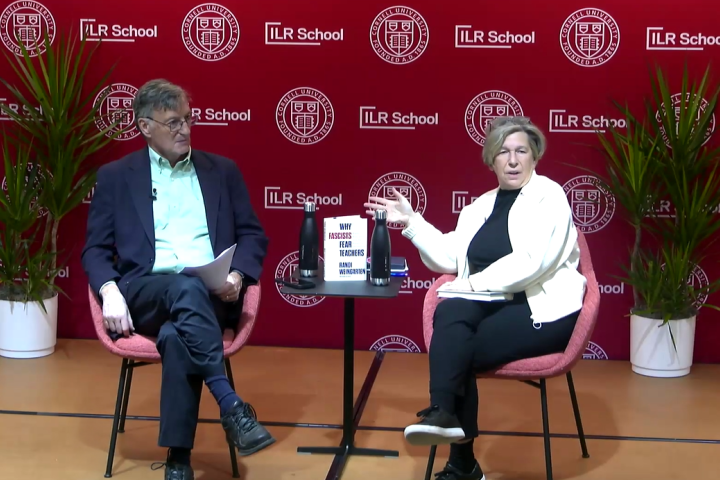
Inside Labor-Management Partnership
John August is the Director of Healthcare Programs at the Scheinman Institute.
Deep inside the largest not-for-profit health system in the nation, Kaiser Permanente, are the thousands of departments, units, patient rooms, utility closets, back-office accounting rooms, call centers, operating rooms, emergency rooms, laboratories, radiology suites, intensive care units, pharmacies…and the people who make them all function. Recently I had the opportunity to have a conference with the frontline leaders of six teams from the union and the management of each team from deep inside Kaiser Permanente.
Among the observations I heard from the experience of leading teams, there was this: “Our unit based teams (UBTs) highlights the Partnership – everyone is on the same level, instead of managers or executives determining what the work ought to be”.
This brief article provides a window into the heart and soul of what has been called “the largest, most complex, ambitious, and broad-based labor-management partnership in U.S. history”. (Kochan, Eaton, McKersie, Adler, Healing Together, ILR Press, 2009, p.2)
Kaiser Permanente serves as many patients in a year as there are entire populations of many nations, such as Bolivia, Belgium, Greece, or Sweden.
And for many years, Kaiser Permanente is regarded as the model for U.S. health care as shown in the below link:
Kaiser Permanente Is Seen as Face of Future Health Care - The New York Times (nytimes.com)
And measured by government data, Kaiser Permanente continues to lead the nation in patient satisfaction:
According to the CMS’ 2021 Star Ratings, Kaiser Permanente Medicare health plans in California, Colorado, Georgia, Hawaii, the Mid-Atlantic states (Maryland, Virginia, and Washington, D.C.), and the Northwest received 5 out of 5 stars, CMS’ highest Medicare star rating. The Kaiser Permanente Medicare health plan in Washington State earned 4.5 out of 5 stars, CMS’ second-highest rating.
This is the 10th consecutive year all Kaiser Permanente Medicare health plans have been rated 4.5 stars or higher. Kaiser Permanente provides care to more than 1.7 million Medicare members in 8 states and the District of Columbia.
Here in ILR-Scheinman, many of our scholars and practitioners study and advance the theory and practice of labor-management innovation, including labor-management partnerships.
And yet, many people ask: “what is a labor-management partnership anyway?”
All labor-management partnerships have at least one thing in common: a recognition that traditional labor-management relations are not producing outcomes for one or both parties that advance their separate or common interests. As such, many efforts at labor management partnership have been undertaken for purposes of attaining “labor peace”, education and training, a reduction in grievance/arbitration, joint efforts to prevent closures or reductions in services, and more recently project-based improvement work.
Whole systems change is quite another matter. Very few health systems have worked with their union counterparts to achieve whole systems change and improvement usually measured by at least four major components of continuous and measurable improvement:
· Quality of care and patient safety
· Patient experience
· Cost and affordability
· The best place to work which includes high employee engagement and retention of a highly engaged workforce
At Kaiser Permanente the labor-management partnership is an integral part of the organizations’ success in achieving continuous improvement as reflected in its highest ratings in the industry. Indeed whole systems change is in the DNA of the labor-management partnership.
I recently explored this high level view with six leaders of unit based teams from the Washington, DC area of Kaiser Permanente. Central to the day-to-day work of the labor-management partnership (LMP) is support for and the success of nearly 4,000 unit based teams among the more than 200,000 employees, managers, and physicians who work for the organization.
All unit based teams are asked to identify how they can contribute to the four (4) strategic categories of improvement listed above. Rather than dictate what type of project to work on, all teams are expected to jointly identify problems to solve, issues to resolve with the patient/member as the central focus of the improvement initiative they choose to work on.
All unit based teams are led by co-leads, one from the union and one from the management. Many are given training in the “rapid improvement model” based on the well-known Model of Improvement as advanced in the Toyota Production System of continuous improvement which identifies goals and then frames analysis and achievement through the process of PDSA (Plan Do Study Act). All are supported by highly skilled Improvement Advisors, recruited and trained from the Kaiser Permanente ranks of frontline workers, physicians, and managers. Most organizations, by contrast, tend to contract out such work to outside consultants.
From the team co-leads I interviewed, we learned about recent successful improvement projects, such as:
· Reconfiguration of unit structure to eliminate injuries on the job
· Improving storeroom communication of supplies which increased speed of delivery of items to patients in pharmacies and on units
· Inventory controls which eliminated waste
· Improving workflow with doctors to increase speed of review of symptoms of patients for diagnosis and treatment
· Building data into electronic medical records to make information instantaneous for diagnosis and treatment
When asked what makes the teams’ work successful, and what the work means, responses included:
· “We all have different ideas, but our UBT model facilitates our ability to come together and solve real problems”
· “We are provided the time to devote to our projects, and we include everyone in the department…we have protected time for our meetings”
· “We feel we have taken control of our workplace which helps with morale and work life balance”
· “We feel that we are contributing to something really important which makes us feel as though we have a career and not a job”.
· “Before unit based teams were encouraged, we had no sense of ownership or any sense of responsibility for fixing real problems”
· “As a union member, unit based teams have helped me see the value of collective bargaining which not only benefits the union employee, but benefits everyone”.
· “You are appreciated regardless of your position…all ideas are valued and appreciated”.
· “I have taken what I have learned from my unit based team and applied it to my life outside of work, which has taught me that there is probably a solution to any problem, if you step back and listen”.
The front line experience within the LMP serves as the most important set of answers and most important answer to the question: “what is a labor-management partnership, anyway”. As experienced in the largest and most successful model of labor-management partnership we have, we see that whole systems change should be a goal so long as teams are organized with consistent attention to autonomy in ownership of improvement work, provided consistent support for and use of effective models of improvement, and overall seen as integral to enterprise and union success.
When we hear from frontline managers and union members that their experience reflects autonomy, improvement method knowledge, and investment of time and resources in successful and continuous problem-solving, we see that whole systems improvement is possible.
“True transformation emanates from where patients receive care, from where the work is actually done, i.e. from the day to day interactions in the work unit”. (from a presentation by Kaiser Permanente Senior Vice President, Barbara Grimm, 2007)
There is so much to explore in the world of labor-management partnership, and we will continue to do so in these pages.



